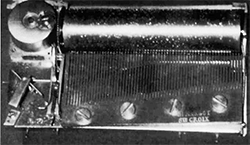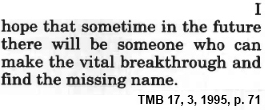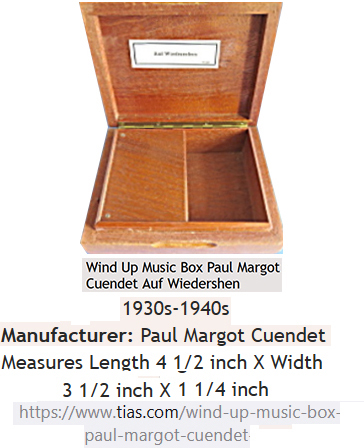|
Die Margots Samuel Margot (?–1829) Ami Margot (1852–1899) Daniel Margot (1899–?) Auguste Margot (1885–1897) Louis, Emile und Albert Margot (Margot Frères, 1897–?) Samuel Margot (? – ?) Until 1829 François Epars continued producing music boxes, in cooperation with local craftsmen such as Samuel Margot, who supplied combs and lent him money now and then.” (Piguet 2004, S. 217-218) Ami Margot (1852–1899) “In any case, the existence of the Ami Margot company in L´Auberson was confirmed in the directory of 1852 and an advertisement published on 22nd October 1853 in the local newspaper added further proof: ‘The person who has found a pile of handwritten musical scores is requested to return it to Ami Margot in L´Auberson, for an appropriate reward’.” (Piguet 2004, p. 255-256) Cooperation with Francis Martin, „who managed to keep up music box sales, for a reasonable commission, well into the years of economic crisis.” (Piguet 2004, p. 257) Exposition universelle in 1855 National exhibition Zurich 1883 “In 1855, Ami Margot went to the Exposition universelle in Paris and to the National Exhibition in Zurich in 1883.” (Piguet 2004, p. 255-256) Emile Cuendet (brother-in-law of Ami Margot), was an agent for Ami Margot, opening the market on the East Coast (Piguet, Music Box Makers, 2004, p. 40) Ami Margot Daniel Margot (1899–?) In 1899, the trade name [Ami Margot] disappeared. His [Ami Margot's] son Daniel Margot continued his music box manufacturing activity, but in a relatively discreet manner.” (Piguet 2004, p. 255-256) The grand-son of Daniel Margot was Frank Margot (*1912, †1989) Auguste Margot (1885–1897) 1885 gründete Auguste Margot eine Firma, die Spielwerke erzeugte. Auguste Margot starb im Jahr 1897. “On 20th June 1885, Auguste Margot set up a comptoir in L´Auberson for the manufacture of music boxes. He specialized in boxes with different mechanisms. After his [Auguste Margot's] death twelve years later his three sons Louis, Emile and Albert Margot carried on the paternal activities.” (Piguet 2004, p. 255-256) Margot Frères (Louis, Emile and Albert Margot, 1897–?, 1901 being music box workers, the partnership ending in 1908) 1897: Auguste Margots drei Söhne Louis, Emile und Albert Margot übernahmen den väterlichen Betrieb. Vermutlich mit wenig Erfolg: 1901 wurden sie nur mehr als Spielwerkarbeiter (und nicht mehr als Fabrikanten) bezeichnet, eine Tätigkeit, die nicht länger als bis zum 21. April 1908 angedauert haben kann. (Piguet, 1996, S. 341) Vielleicht war Emile Margot 1889 in den USA, um dort als Zeuge bei einer Patenteinreichung zu fungieren und zu unterschreiben. “After [Auguste Margot's death in 1897] his three sons Louis, Emile and Albert Margot carried on the paternal activities and went into partnership under the name Margot Frères. However, in 1901, in the local directory, they referred to themselves as music box workers and not manufacturers.” “Nothing is known about the products they made, except that the partnership ended on 21st April 1908.” Henri Margot und G. Margot
1831: Henri Margot, acteur preparager (manufacturer) in La Sagne 1832: manufacturer and trader of music boxes 1840: a two-tune movement in a tin box sold for 8.50 francs Snuffbox type, marked Henri Margot Sainte-Croix or HMG Considerable production up to serial number 41,847 1851: Henri Margot municipal councillor, carrying on his manufacturing activities 1852: Henri Margot Justice of the Peace, progressively abandon the production of music boxes over the following years Salomon Margot, watchmaker towards the end of the 18th century, takes interest in music boxes
Spielwerke von Henri Margot A. Margot-Cuendet Auberson, Switzerland. Musical boxes. Paul Margot-Cuendet “Paul Margot, cabinetmaker in L ´Auberson (the company subsequently run by his son Denis) was general representative for Switzerland at the time [1963]. The latter [Denis Margot] bought movements from Mélodies, made the boxes, and assembled and sold them in the country.“ (Piguet 2004, p. 262-264)
Frank Margot (*1912, †1989) “His [Daniel Margot's] grandson, Frank, born in 1912, had to take over the family farm at the age of sixteen. He nevertheless pursued his music studies and obtained a second place at the finals of the Ecole universelle of Paris. And there he was, a musician at last! But dreaming aside, it was in L´Auberson that his career opportunity lay.” (Piguet 2004, p. 255-256) [René-Louis] Jacques et Margot / Ziboc “In 1945, when he [Frank Margot] was the only one to provide for the family and music box orders suddenly began rolling in, he created a new company under the name Jacques et Margot, as [René] Jaques the combtuner was in partnership with René-Louis Jaques, son of Arthur.” (Piguet 2004, p. 255-256) “Then came the music box boom years. There was ample work for competent people who were not afraid to get their hands dirty. Jaques et Margot employed three people in the workshop situated at the Grand-Rue 32, with about twenty more at home. But the two partners preferred music to running their business as such. They were reputed to be original and full of ideas. Year after year, they took turns in managing the company and chose the trademark Ziboc, contraction of Zibeline, Jaques´ nickname, and Bochum, Margot´s nickname (the by-product of a children´s game).” (Piguet 2004, p. 255-256) “In 1952, René Jaques withdrew from the partnership and Frank Margot carried on in his own name, until he died on 14th February 1989. He worked closely with many music box manufacturers in L´Auberson, for whom he made musical arrangements and of course did some tuning, in which he was recognized as an absolute master.” (Piguet 2004, p. 255-256) “When some complicated music had to be tuned, when an antique box of which the comb had lost a certain number of teeth needed to be restored, people turned to Frank Margot. He took great pleasure in carrying out complicated tasks and to see a newly pinned cylinder or to listen to a tune he had arranged, filled him with immense joy.” (Piguet 2004, p. 255-256) “Like all music box pioneers, Frank Margot was a true musician. He was endowed with what he liked to call “a good ear” (perfect pitch). He played in an orchestra for a few years, was a much appreciated actor and faithful conductor of lay and religious choirs. For music box amateurs he was the ‘soul’ of the industry for many years.” (Piguet 2004, p. 255-256)
Music boxes / Spielwerke von Frank Margot Music boxes / Spielwerke von Frank Margot
|




